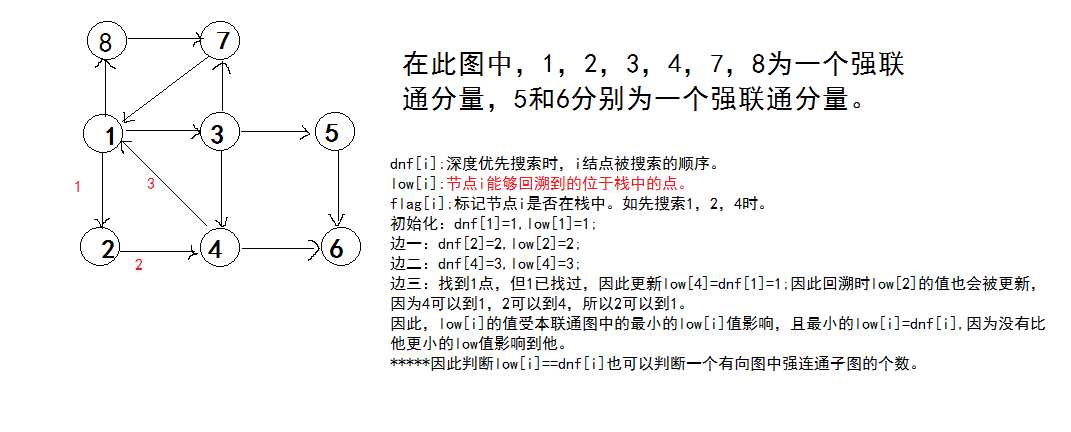标签:tac col type 代码 exp nbsp image name syn
在有向图中,若两点至少包含一条路径可以到达,则称两个顶点强连通,若任意两个顶点皆如此,则称此图为强联通图。非强连通图有向图的极大强连通子图,称为强连通分量(strongly connected components)。

中间查找过程类似于深度优先搜索和并查集。
代码实现:
#include <iostream> #include <algorithm> #include <cstring> #include <cstdio> #include <vector> #include <queue> #include <stack> #include <cstdlib> #include <iomanip> #include <cmath> #include <cassert> #include <ctime> #include <cstdlib> #include <map> #include <set> using namespace std; #pragma comment(linker, "/stck:1024000000,1024000000") #define lowbit(x) (x&(-x)) #define max(x,y) (x>=y?x:y) #define min(x,y) (x<=y?x:y) #define MAX 100000000000000000 #define MOD 1000000007 #define pi acos(-1.0) #define ei exp(1) #define PI 3.1415926535897932384626433832 #define ios() ios::sync_with_stdio(true) #define INF 1044266558 #define mem(a) (memset(a,0,sizeof(a))) typedef long long ll; int dnf[10],low[10],pos[10],vis[10]; int n,k=-1,g[10][10],ans=1,m,num=0; void tarjan(int u) { dnf[u]=low[u]=ans++; pos[++k]=u; vis[u]=1; for(int i=1;i<=n;i++) { if(g[u][i]) { if(!dnf[i]) { tarjan(i); low[u]=min(low[u],low[i]); } else { if(vis[i]) low[u]=min(dnf[u],low[i]); } } } int cnt; if(dnf[u]==low[u]) { printf("Case #%d: ",++num); do { cnt=pos[k--]; printf("%d ",cnt); vis[cnt]=0; }while(cnt!=u); printf("\n"); } } int main() { scanf("%d%d",&n,&m); memset(g,0,sizeof(g)); memset(dnf,0,sizeof(dnf)); memset(low,0,sizeof(low)); memset(pos,0,sizeof(pos)); for(int i=0;i<m;i++) { int x,y; scanf("%d%d",&x,&y); g[x][y]=1; } printf("\n\n"); tarjan(1); printf("************************\n"); printf("The number of the strongly connected components: %d\n",num); printf("************************\n"); for(int i=1;i<=n;i++) { printf("dnf[%d]:%d low[%d]:%d\n",i,dnf[i],i,low[i]); } return 0; } /* 8 12 1 3 1 2 1 8 8 7 7 1 3 7 2 4 4 1 3 4 3 5 4 6 5 6 */
标签:tac col type 代码 exp nbsp image name syn
原文地址:http://www.cnblogs.com/shinianhuanniyijuhaojiubujian/p/7617336.html